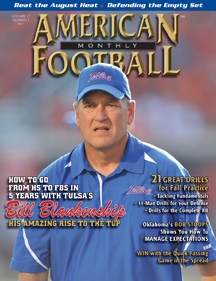Article CategoriesAFM Magazine
|
Utilizing the Quick Passing Game in a Spread Offenseby: Drew DallasQuarterbacks Coach • Kansas Wesleyan University © More from this issue At Kansas Wesleyan, one of the key components of our spread offense is being able to successfully utilize the quick passing game. Our offense is based out of a single back, 2 x 2 formation. One of our main objectives is keep things simple. This ranges from route concepts, protections, signals and words. As an offensive staff, we strive to get players to react instead of over-thinking. We encourage our players to be athletes and make plays based on reaction. In this article, we will discuss the basic principles within our quick passing game as well as take a look at the basic assignments and responsibilities of each position group. The two main principles that we feel are essential for our success include protecting the quarterback and route concepts. These two things are our main focus in game planning and practice throughout the week.....The full article can only be seen by subscribers.
|
|
|||||||
| HOME |
MAGAZINE |
SUBSCRIBE | ONLINE COLUMNISTS | COACHING VIDEOS |
Copyright 2025, AmericanFootballMonthly.com
All Rights Reserved





